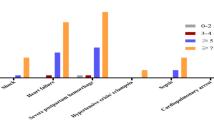Abstract
Objective
To assess the applicability of WHO Maternal Severity Score (MSS) and Maternal Severity Index (MSI) Model in near miss (NM) obstetric patients
Methods
It was a prospective observational study conducted at a tertiary health care center from July 2015 to Feb 2016. All patients fulfilling one or more WHO NM criteria were included. MSS and MSI were calculated for all NM patients on admission. They were then followed up till the final outcome (NM or death). Each NM parameter, system-wise MSS, total MSS and MSI were then associated with the final outcome.
Results
Of 4822 patients, 1739 had potentially life-threatening conditions of which 174 were identified as NM. The average MSS and MSI of patients who remained NM was 4.41 and 11.67%, respectively, and those who died was 9.47 and 58.16%, respectively. Both were found to be significantly associated with the outcome (p < 0.001). MSI had good accuracy for maternal death prediction in women with markers of organ dysfunction (AUROC – 0.838 [95% CI 0.766–0.910]). However, of 25 NM criteria, only 17 NM criteria and 3 system dysfunctions (cardiovascular, respiratory and neurological) were found to associate significantly with the outcome.
Conclusion
MSS and MSI act as good prognostic tools to assess the severity of maternal complications and estimate the probability of death in NM patients. As all NM parameters are not equally predictive of severity of maternal morbidity, different scores per NM parameter and system should be assigned while calculating MSS for better prognostication.




Similar content being viewed by others
References
Kasahun AW, WakoWG, (2018) Predictors of maternal near miss among women admitted in Gurage zone hospitals, South Ethiopia, 2017: a case control study. BMC Pregn Childbirth 18:260
Stones W, Lim W, Al-Azzawi F, Kelly M (1991) An investigation of maternal morbidity with identification of life-threatening 'near miss' episodes. Health Trends 23(1):13–15
Goldenberg RL, Saleem S, Ali S, Moore JL, Lokangako A, Tshefu A et al (2017) Maternal near miss in low-resource areas. Int J Gynaecol Obstet 138(3):347–355
Say L, Souza JP, Pattinson RC (2009) Maternal near miss-towards a standard tool for monitoring quality of maternal health care. Best Pract Res Clin Obstet Gynaecol 23(3):287–296
Lapinsky SE, Hallett D, Collop N, Drover J, Lavercombe P, Leeman M et al (2011) Evaluation of standard and modified severity of illness scores in the obstetric patient. J Crit Care 26(5):535.e1–535.e7
Souza JP, Cecatti JG, Haddad SM, Parpinelli MA, Costa ML, Katz L et al (2012) The WHO maternal near-miss approach and the maternal severity index model (MSI): tools for assessing the management of severe maternal morbidity. PLoS One 7(8):e44129
Souza JP, Gulmezoglu AM, Vogel J, Carroli G, Lumbiganon P, Qureshi Z et al (2013) Moving beyond essential interventions for reduction of maternal mortality (the WHO Multicountry Survey on Maternal and Newborn Health): a cross-sectional study. Lancet 381(9879):1747–1755
Nakimuli A, Nakubulwa S, Kakaire O, Osinde MO, Mbalinda SN, Nabirye RC et al (2016) Maternal near misses from two referral hospitals in Uganda: a prospective cohort study on incidence, determinants and prognostic factors. BMC Pregn Childbirth 16:24
Litorp H, Kidanto HL, Nystrom L, Darj E, Essén B (2013) Increasing caesarean section rates among low-risk groups: A panel study classifying deliveries according to Robson at a university hospital in Tanzania. BMC Pregn Childbirth 13:107
Norhayati MN, Nik Hazlina NH, Sulaiman Z, Azman MY (2016) Severe maternal morbidity and near misses in tertiary hospitals, Kelantan, Malaysia: a cross-sectional study. BMC Public Health 16:229
Oladapo OT, Adetoro OO, Ekele BA, Chama C, Etuk SJ, Aboyeji AP et al (2016) When getting there is not enough: a nationwide cross-sectional study of 998 maternal deaths and 1451 near-misses in public tertiary hospitals in a low-income country. BJOG 123(6):928–938
Cecatti JG, Souza JP, Oliveira Neto AF, Parpinelli MA, Sousa MH, Say L et al (2011) Pre-validation of the WHO organ dysfunction based criteria for identification of maternal near miss. Reprod Health 8:22
Jabir M, Abdul-Salam I, Suheil DM, Al-Hilli W, Abul-Hassan S, Al-Zuheiri A et al (2013) Maternal near miss and quality of maternal health care in Baghdad. Iraq. BMC Pregn Childbirth 13:11
Haddad SM, Cecatti JG, Souza JP, Sousa MH, Parpinelli MA, Costa ML et al (2014) Applying the maternal near miss approach for the evaluation of quality of obstetric care: a worked example from a multicenter surveillance study. Biomed Res Int 2014:989815
Acknowledgements
We would like to acknowledge the hospital staff and resident doctors for their valuable help in collecting all NM. We would also extend our gratitude to Dr Sandeep Satsangi for his contribution in manuscript preparation.
Funding
None.
Author information
Authors and Affiliations
Contributions
All authors contributed significantly to manuscript preparation. RP was involved in study setup, study design, data review and analysis, data management and drafting of manuscript. VJ conceived the study, participated in study design, data management and manuscript editing. RB and PS performed data review and edited the manuscript. KJ contributed in data analysis and manuscript editing.
Corresponding author
Ethics declarations
Conflict of interest
All authors declare that they have no conflicts of interest.
Ethics approval
The study was reviewed and approved by the institute’s ethics committee, PGIMER, Chandigarh, on 11/9/2015 (Reference Number- NK/2210/MD/9907–08).
Informed consent
An informed written consent was obtained from patients/relatives after fully explaining the nature and purpose of study.
Research on animals or humans
This study did not involve any research conducted on animals. An informed written consent was obtained from patients/relatives after fully explaining the nature and purpose of study.
Additional information
Publisher's Note
Springer Nature remains neutral with regard to jurisdictional claims in published maps and institutional affiliations.
Rights and permissions
About this article
Cite this article
Pandit, R., Jain, V., Bagga, R. et al. Applicability of WHO Maternal Severity Score (MSS) and Maternal Severity Index (MSI) Model to predict the maternal outcome in near miss obstetric patients: a prospective observational study. Arch Gynecol Obstet 300, 49–57 (2019). https://doi.org/10.1007/s00404-019-05159-z
Received:
Accepted:
Published:
Issue Date:
DOI: https://doi.org/10.1007/s00404-019-05159-z




